| Listing 1 - 10 of 16 | << page >> |
Sort by
|
Book
ISBN: 3540711058 Year: 2007 Publisher: Berlin, Heidelberg : Springer Berlin Heidelberg : Imprint: Springer,
Abstract | Keywords | Export | Availability | Bookmark
 Loading...
Loading...Choose an application
- Reference Manager
- EndNote
- RefWorks (Direct export to RefWorks)
Die modernen Konzepte der physikalischen Metallkunde sind gleichermaßen grundlegend für das Verständnis aller nichtmetallischen Werkstoffe. Deswegen und der wachsenden Bedeutung der Verbundwerkstoffe wegen liegt es nahe, die klassisch nach den drei Werkstoffen Metall, Keramik und Kunststoff differenzierten Wissensgebiete unter der verbindenden Bezeichnung Werkstoffwissenschaft gemeinsam abzuhandeln. Von dieser Feststellung ausgehend will dieses Lehrbuch zwar zunächst in die Allgemeine Metallkunde einführen, damit und darüber hinaus aber auch die Grundlagen für die gesamten Werkstoffwissenschaften legen. Im Mittelpunkt steht dabei fraglos der naturwissenschaftliche Aspekt der Materialkunde, ohne daß deswegen aber ihr ingenieurwissenschaftlicher Anteil vernachlässigt wurde. Dieses Konzept wird auch in dieser inzwischen dritten Auflage erfolgreich umgesetzt. Modernen Entwicklungen wurde vor allem durch wesentliche Erweiterungen über quantitative Kristallographie Rechnung getragen.
Materials science. --- Metals. --- Crystallography. --- Engineering. --- Materials Science, general. --- Metallic Materials. --- Crystallography and Scattering Methods. --- Engineering, general.
Book
ISBN: 3540681124 Year: 2007 Publisher: Berlin ; Heidelberg : Springer-Verlag Berlin Heidelberg,
Abstract | Keywords | Export | Availability | Bookmark
 Loading...
Loading...Choose an application
- Reference Manager
- EndNote
- RefWorks (Direct export to RefWorks)
Die Pulvermetallurgie bietet für beliebige Komponenten Verbundtechniken und -werkstoffe an, die der Schmelzmetallurgie versagt sind. Unter diesen Gesichtspunkten werden die wichtigsten Verfahren der Gewinnung, Aufbereitung und Charakterisierung der Pulver, deren Formgebung zu Halbzeugen und Konstruktionsteilen behandelt. Die Technologien und Anlagen des Sinterns - der zentralen Technologie der Pulvermetallurgie - werden in der Neuauflage ausführlich behandelt. Einen ebenso breiten Raum nimmt die Darstellung der gesinterten Formteile auf Eisen- und Nichteisenbasis, aus hoch- und höchstfesten Legierungen, von Reib- und Gleitelementen, porösen Materialien, Kontakt- und Magnetwerkstoffen, hochschmelzenden Metallen, Hartmetallen und anderen Metall-Nichtmetall-Verbundwerkstoffen ein. Ökonomische Vorteile, wie die prozessstufenärmere und weitgehend abfallfreie Fertigung von maßgenauen Massenformteilen, die Einstellung nichtkonservativer Werkstoffzustände und der entsprechenden Materialeigenschaftsbilder, werden in diesem Werk deutlich.
Materials science. --- Condensed matter. --- Metals. --- Characterization and Evaluation of Materials. --- Condensed Matter Physics. --- Metallic Materials. --- Metallurgy. --- Powder metallurgy.
Book
ISBN: 354069451X Year: 2007 Publisher: Berlin ; Heidelberg : Springer-Verlag,
Abstract | Keywords | Export | Availability | Bookmark
 Loading...
Loading...Choose an application
- Reference Manager
- EndNote
- RefWorks (Direct export to RefWorks)
Das Wissen über Aluminium ist im letzten Jahrzehnt – dank des gestiegenen Interesses der Automobil- und Luftfahrtindustrie an diesem Leichtbauwerkstoff – enorm gewachsen. Neue Legierungen und differenziertere Behandlungsprozesse erweitern das Verarbeitungs- und Anwendungsspektrum. Werkstoffgerechte Konstruktion und wirtschaftliche Verarbeitung setzen gründliche Kenntnisse der besonderen Gebrauchseigenschaften voraus. Ziel des Buches ist es, detaillierte Zusammenhänge zwischen Werkstoffwahl, Verarbeitungs- und Gebrauchseigenschaften zu vermitteln, um das erweiterte Anwendungspotenzial innovativ nutzen zu können. Die nach fast 10 Jahren erscheinende, völlig neubearbeitete 2. Auflage enthält aktuelle Informationen über Legierungsentwicklungen, Werkstoffdaten und Normen. Eine detaillierte Darstellung der Einflüsse von Gefügezustand und Gefügeveränderungen auf das Werkstoffverhalten wurde aufgenommen. Eine große Zahl von Illustrationen veranschaulicht das umfangreiche Material, das durch ein Tabellenwerk mit typischen Werkstoffdaten, die bei der Legierungsauswahl helfen, ergänzt ist. Das Werk eignet sich wegen seiner Stoff- und Datenfülle sowie zahlreicher Literaturquellen gleichermaßen als Lehrbuch und Nachschlagewerk für Ingenieure in der Forschung, Entwicklung und industriellen Praxis.
Materials science. --- Metals. --- Engineering design. --- Machinery. --- Manufactures. --- Characterization and Evaluation of Materials. --- Metallic Materials. --- Engineering Design. --- Machinery and Machine Elements. --- Manufacturing, Machines, Tools, Processes. --- Aluminum. --- Metallurgy.
Book
ISBN: 1281086460 9786611086466 3540684700 Year: 2007 Publisher: Berlin, Heidelberg : Springer-Verlag,
Abstract | Keywords | Export | Availability | Bookmark
 Loading...
Loading...Choose an application
- Reference Manager
- EndNote
- RefWorks (Direct export to RefWorks)
Die Schraube ist das am häufigsten eingesetzte Maschinenelement. Schraubenverbindungen behandelt in ganzheitlicher Form alle Einflussfaktoren auf das funktionelle Verhalten von Schraubenverbindungen in den verschiedensten Anwendungsgebieten. Seit dem Erscheinen der 4. Auflage im Jahre 1988 hat sich das Gebiet auf vielfältige Weise weiterentwickelt. Diesen Veränderungen wird in der Neuauflage Rechnung getragen: dies betrifft vor allem das Kapitel Normung sowie die Berechnung, die sich auf die aktualisierte VDI-Richtlinie 2230 bezieht. Neuere Forschungsergebnisse finden sich in den Kapiteln über Tragfähigkeit und Temperaturverhalten, innovative Oberflächenschutzmaßnahmen in demjenigen über Korrosion, neuartige Geräte und automatisierte Methoden im Montagekapitel.
Machinery. --- Mechanical engineering. --- Metals. --- Structural materials. --- Mechanics. --- Mechanics, Applied. --- Manufactures. --- Machinery and Machine Elements. --- Mechanical Engineering. --- Metallic Materials. --- Structural Materials. --- Solid Mechanics. --- Manufacturing, Machines, Tools, Processes. --- Civil engineering. --- Materials.
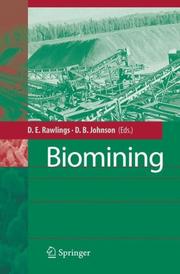
ISBN: 1280727268 9786610727261 3540349111 354034909X 3642071155 Year: 2007 Publisher: Berlin : Springer,
Abstract | Keywords | Export | Availability | Bookmark
 Loading...
Loading...Choose an application
- Reference Manager
- EndNote
- RefWorks (Direct export to RefWorks)
Biomining is the biotechnology that uses microorganisms to recover metals, in particular copper and gold, from ores and concentrates. Having developed from a very simple operational (in terms of both engineering and biology) process, biomining has developed into a multifaceted technology, to the extent that many of the largest industrial stirred tanks and heaps throughout the world are employed for bioprocessing minerals. This book has a strong applied approach and describes emerging and established industrial processes, as well as the underlying theory of the process, and the biology of the microorganisms involved. Chapters have been written by personnel from leading biomining companies, consultants and internationally recognized researchers and academics.
Minerals --- Biotechnology. --- Chemical engineering --- Genetic engineering --- Biomining --- Mineral bioprocessing --- Mineral biotechnology --- Biotechnology --- Metallurgy --- Mining engineering --- Microbiology. --- Materials. --- Microbial ecology. --- Geochemistry. --- Metallic Materials. --- Microbial Ecology. --- Biogeosciences. --- Chemical composition of the earth --- Chemical geology --- Geological chemistry --- Geology, Chemical --- Chemistry --- Earth sciences --- Environmental microbiology --- Microorganisms --- Ecology --- Microbiology --- Engineering --- Engineering materials --- Industrial materials --- Engineering design --- Manufacturing processes --- Microbial biology --- Biology --- Materials --- Metals. --- Geobiology. --- Biosphere --- Metallic elements --- Chemical elements --- Ores
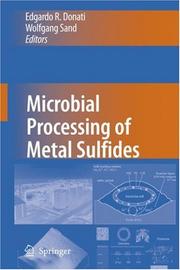
ISBN: 1280865199 9786610865192 1402055897 1402055889 9048174023 9781402055881 9781402055898 Year: 2007 Publisher: Dordrecht : Springer,
Abstract | Keywords | Export | Availability | Bookmark
 Loading...
Loading...Choose an application
- Reference Manager
- EndNote
- RefWorks (Direct export to RefWorks)
The application of microbiological methods to the extraction of metals from minerals has definitely gained a prominent role and is supported by the several bioleaching and biooxidation processes operating in different sites over the world. In recent years new techniques and new results about proteomic and bioinformatics are bringing a new perspective on the microbial processes. This book focuses on the basic aspects of the process with special emphasis on recent contributions regarding the chemical and microbial aspects of the bioleaching process and the use of microorganisms in the treatment of complex ores and concentrates. It has been written by recognized researchers in order to introduce the main subjects of microbial processing to undergraduate and postgraduate students, scientists working in this field as well as interested industrialists.
Sulfides --- Minerals --- Microbial biotechnology. --- Metallurgy. --- Biotechnology. --- Microorganisms --- Biotechnology --- Industrial microbiology --- Biotechnological microorganisms --- Biomining --- Mineral bioprocessing --- Mineral biotechnology --- Metallurgy --- Mining engineering --- Materials. --- Microbiology. --- Biochemical engineering. --- Mineral resources. --- Bioinformatics. --- Microbial ecology. --- Metallic Materials. --- Applied Microbiology. --- Biochemical Engineering. --- Mineral Resources. --- Microbial Ecology. --- Bio-informatics --- Biological informatics --- Biology --- Information science --- Computational biology --- Systems biology --- Deposits, Mineral --- Mineral deposits --- Mineral resources --- Mines and mining --- Mining --- Natural resources --- Geology, Economic --- Bio-process engineering --- Bioprocess engineering --- Biochemistry --- Chemical engineering --- Environmental microbiology --- Ecology --- Microbiology --- Microbial biology --- Engineering --- Engineering materials --- Industrial materials --- Engineering design --- Manufacturing processes --- Data processing --- Materials --- Metals. --- Metallic elements --- Chemical elements --- Ores --- Sulfures (minéralogie) --- Minéraux --- Microorganismes --- Biotechnologie
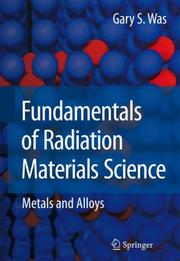
ISBN: 3540494723 3540494715 Year: 2007 Publisher: Berlin, Heidelberg : Springer Berlin Heidelberg : Imprint: Springer,
Abstract | Keywords | Export | Availability | Bookmark
 Loading...
Loading...Choose an application
- Reference Manager
- EndNote
- RefWorks (Direct export to RefWorks)
Radiation Materials Science teaches readers the fundamentals of the effects of radiation on metals and alloys. When energetic particles strike a solid, numerous processes occur that can change the physical and mechanical properties of the material. Metals and alloys represent an important class of materials that, by virtue of their use in nuclear reactor cores, are subject to intense radiation fields. Radiation causes metals and alloys to swell, distort, blister, harden, soften and deform. This textbook and reference covers the basics of particle-atom interaction for a range of particle types, the amount and spatial extent of the resulting radiation damage, the physical effects of irradiation and the changes in mechanical behavior of irradiated metals and alloys. Concepts are developed systematically and quantitatively, supported by examples, references for further reading and problems at the end of each chapter. Beyond addressing students enrolling for a materials sciences or nuclear engineering degree, the book will benefit professionals in laboratories, reactor manufacturers and specialists working in the utility industry.
Metals --- Radiation --- Effect of radiation on. --- Measurement. --- Radiation monitoring --- Radiometry --- Electromagnetic measurements --- Metals, Effect of radiation on --- Materials. --- Nuclear physics. --- Metallic Materials. --- Nuclear Energy. --- Nuclear Physics, Heavy Ions, Hadrons. --- Atomic nuclei --- Atoms, Nuclei of --- Nucleus of the atom --- Physics --- Engineering --- Engineering materials --- Industrial materials --- Engineering design --- Manufacturing processes --- Materials --- Metals. --- Nuclear energy. --- Heavy ions. --- Ions --- Atomic energy --- Atomic power --- Energy, Atomic --- Energy, Nuclear --- Nuclear power --- Power, Atomic --- Power, Nuclear --- Force and energy --- Nuclear physics --- Power resources --- Nuclear engineering --- Nuclear facilities --- Nuclear power plants --- Metallic elements --- Chemical elements --- Ores --- Metallurgy
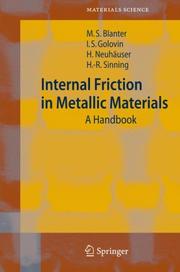
ISBN: 3540687580 3540687572 3642088252 Year: 2007 Publisher: Berlin : Springer-Verlag GmbH,
Abstract | Keywords | Export | Availability | Bookmark
 Loading...
Loading...Choose an application
- Reference Manager
- EndNote
- RefWorks (Direct export to RefWorks)
This book is a unique collection of experimental data in the field of internal friction, anelastic relaxation, and damping properties of metallic materials. It reviews virtually all anelastic relaxation phenomena ever published, and also most of the internal friction effects based on other types of dissipation of mechanical (elastic) energy. Furthermore, the reader is also supplied with explanations of the basic physical mechanisms of internal friction, a summary of typical effects for different groups of metals, and more than 2000 references to original papers.
Internal friction. --- Metals --- Elastic properties. --- Anelasticity --- Damping (Mechanics) --- Elastic solids --- Elastic waves --- Friction --- Vibration --- Materials. --- Chemistry, inorganic. --- Engineering. --- Metallic Materials. --- Tribology, Corrosion and Coatings. --- Engineering, general. --- Construction --- Industrial arts --- Technology --- Inorganic chemistry --- Chemistry --- Inorganic compounds --- Engineering --- Engineering materials --- Industrial materials --- Engineering design --- Manufacturing processes --- Materials --- Metals. --- Tribology. --- Corrosion and anti-corrosives. --- Coatings. --- Surface coatings --- Surfaces (Technology) --- Coating processes --- Thin films --- Anti-corrosive paint --- Atmospheric corrosion --- Metal corrosion --- Rust --- Rustless coatings --- Chemical inhibitors --- Chemistry, Technical --- Fouling --- Weathering --- Paint --- Protective coatings --- Waterproofing --- Metallic elements --- Chemical elements --- Ores --- Metallurgy --- Corrosion --- Deterioration --- Surfaces
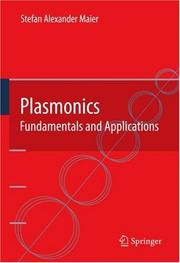
ISBN: 9780387331508 9780387378251 0387331506 1441941134 9786610865888 0387378251 1280865881 Year: 2007 Publisher: New York : Springer,
Abstract | Keywords | Export | Availability | Bookmark
 Loading...
Loading...Choose an application
- Reference Manager
- EndNote
- RefWorks (Direct export to RefWorks)
Considered one of the major fields of photonics of the beginning 21st century, plasmonics offers the potential to confine and guide light below the diffraction limit and promises a new generation of highly miniaturized photonic devices. Offering both a comprehensive introduction to the field and an extensive overview of the current state of the art, "Plasmonics: Fundamentals and Applications" should be of great value to the newcomer and to the experienced researcher. The first part of the book describes the fundamentals of this research area, starting with a review of Maxwell’s equations in a form suited to the description of metals. Subsequent chapters introduce the two major ingredients of plasmonics, surface plasmon polaritons at metallic interfaces and localized plasmons in nanostructures. The mathematics of their description, excitation and imaging of the modes are discussed. This part closes with a presentation of electromagnetic surface waves at lower frequencies in the THz and microwave regime, comprising both spoof or designer plasmons and surface phonon polaritons. Building on the fundamentals, the second part discusses some of the most prominent applications of plasmons: Plasmon waveguides, extraordinary transmission through aperture arrays, sensing and surface enhanced Raman scattering, spectroscopy as well as metamaterials. Exemplary studies in each of these fields taken from the original literature are presented.
Electronics and optics of solids --- Plasmons (Physics) --- Photonics. --- Photonics --- Plasmons --- Photonique --- EPUB-LIV-FT LIVCHIMI SPRINGER-B --- Optical materials. --- Nanotechnology. --- Surfaces (Physics). --- Materials. --- Optical and Electronic Materials. --- Condensed Matter Physics. --- Surfaces and Interfaces, Thin Films. --- Metallic Materials. --- Engineering --- Engineering materials --- Industrial materials --- Engineering design --- Manufacturing processes --- Physics --- Surface chemistry --- Surfaces (Technology) --- Molecular technology --- Nanoscale technology --- High technology --- Optics --- Materials --- Electronic materials. --- Condensed matter. --- Materials—Surfaces. --- Thin films. --- Metals. --- Metallic elements --- Chemical elements --- Ores --- Metallurgy --- Films, Thin --- Solid film --- Solid state electronics --- Solids --- Coatings --- Thick films --- Condensed materials --- Condensed media --- Condensed phase --- Materials, Condensed --- Media, Condensed --- Phase, Condensed --- Liquids --- Matter --- Electronic materials
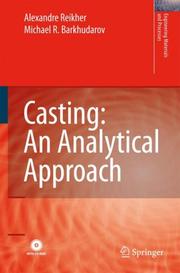
ISBN: 1280944099 9786610944095 1846288509 1846288495 144715973X Year: 2007 Publisher: London : Springer,
Abstract | Keywords | Export | Availability | Bookmark
 Loading...
Loading...Choose an application
- Reference Manager
- EndNote
- RefWorks (Direct export to RefWorks)
For a long time, the die cast industry has used trial and error as a leading development method, resulting in tremendous growth in the utilisation of available CFD (computational fluid dynamics) software. This software allows the development of better products that maximise the advantages the die cast process has to offer. Casting: An Analytical Approach will refresh knowledge of the governing laws of the fluid dynamics that have an effect on die cast die and die cast process design. MATLAB® (MathWorks, Inc.) and Visual Basic® (Microsoft) code are listed in Casting: An Analytical Approach for every stage of product, die and die cast process design; providing better understanding of die and process design and simplifying calculations of the die cast die as well as the die cast process. Gas ventilation system calculations and fundamentals of compressible gas flow are also included. Readers will learn about: the advantages and limitations of the die cast process; the implications that product design has on the quality of the die cast part; how die cast die and process design can affect the physical properties of the casting; the calculations die cast die and process designers have to do; choosing the die cast machine size and the proper gate size; and how to properly design gas ventilation systems, identify an ideal fill time, and calculate fast and slow shot velocity. The use of MATLAB® and Visual Basic® code to illustrate every stage of the design will help readers to gain a better understanding of the importance of collaboration throughout the entire process. Therefore, Casting: An Analytical Approach will be of interest to product designers who design die cast parts, and die cast die and process engineers and designers.
Founding. --- Engineering. --- Construction --- Industrial arts --- Technology --- Casting --- Foundry practice --- Metal-work --- Patternmaking --- Industrial engineering. --- Mechanics. --- Mechanics, Applied. --- Hydraulic engineering. --- Computer simulation. --- Materials. --- Industrial and Production Engineering. --- Solid Mechanics. --- Engineering Fluid Dynamics. --- Simulation and Modeling. --- Metallic Materials. --- Computer modeling --- Computer models --- Modeling, Computer --- Models, Computer --- Simulation, Computer --- Electromechanical analogies --- Mathematical models --- Simulation methods --- Model-integrated computing --- Engineering --- Engineering materials --- Industrial materials --- Engineering design --- Manufacturing processes --- Engineering, Hydraulic --- Fluid mechanics --- Hydraulics --- Shore protection --- Applied mechanics --- Engineering, Mechanical --- Engineering mathematics --- Classical mechanics --- Newtonian mechanics --- Physics --- Dynamics --- Quantum theory --- Management engineering --- Simplification in industry --- Value analysis (Cost control) --- Materials --- Production engineering. --- Fluid mechanics. --- Metals. --- Metallic elements --- Chemical elements --- Ores --- Metallurgy --- Hydromechanics --- Continuum mechanics --- Manufacturing engineering --- Process engineering --- Industrial engineering --- Mechanical engineering
| Listing 1 - 10 of 16 | << page >> |
Sort by
|

 Search
Search Feedback
Feedback About UniCat
About UniCat  Help
Help News
News